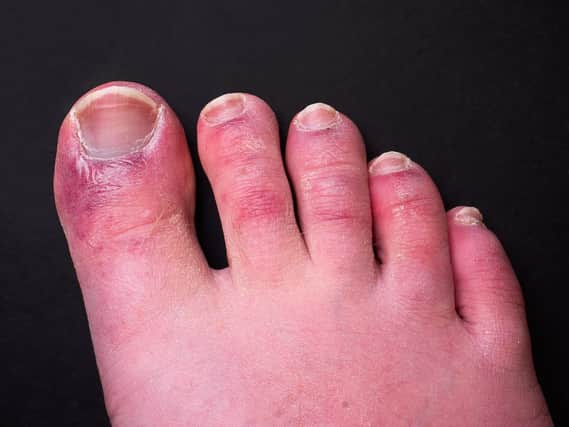What is Covid toe? Symptoms of side effect from virus - and what causes the skin condition


‘Covid toe’ could be a side effect of the immune system’s response to coronavirus, a new study has found.
But what is Covid toe, what are the symptoms of the condition and what causes it?
Here’s what you need to know.
What is Covid toe and what are the symptoms?
Advertisement
Advertisement
The symptoms of Covid toe include chilblain-like inflammation and redness on the hands and feet, with the condition sometimes lasting for months at a time.
It typically develops within a week to four weeks of being infected with Covid and can result in toes and fingers becoming swollen or changing colour.
It can occur in people of any age, but affects children and teenagers more commonly.
For some the condition is painless, but for others the rash can be extremely sore and itchy, with tender blisters and swelling.
Advertisement
Advertisement
The affected skin, which is usually the toes, but sometimes the fingers, can look red or purple and some people develop painful raised bumps or areas of rough skin. There can also be pus and some may have the condition for weeks or even months.
What are chilblains and how does this differ from Covid toe?
Chilblains are small, itchy, red patches that can appear after you have been in the cold.
Chilblains usually appear a few hours after you have been in the cold and you mostly get them on your fingers and toes, but can also get them on your face and legs.
They usually clear up on their own in two to three weeks, but you may need to see a GP if they do not go away.
What causes Covid toe?
Advertisement
Advertisement
A new study - published in the British Journal of Dermatology - has found that Covid toe could be a side effect of the immune system’s response to coronavirus.
Researchers behind the study examined 50 participants with Covid toe and 13 with similar chilblains lesions that arose before the pandemic.
The study found that one mechanism behind both types of the condition involved the body generating an immune response with high levels of certain autoantibodies, which mistakenly target and react with a person’s own cells and tissues as well as the invading virus.
Researchers also found an overlap with type I interferon, which is a key protein in the antiviral response.
Advertisement
Advertisement
Cells lining blood vessels which supply the affected areas also appeared to play a critical role in the development of Covid toe and chilblains.
Senior author of the study, Dr Charles Cassius, said the research provided a deeper understanding of the condition.
He said: “The epidemiology and clinical features of chilblain-like lesions have been extensively studied and published, however, little is known about the pathophysiology involved.
“Our study provides new insights.”